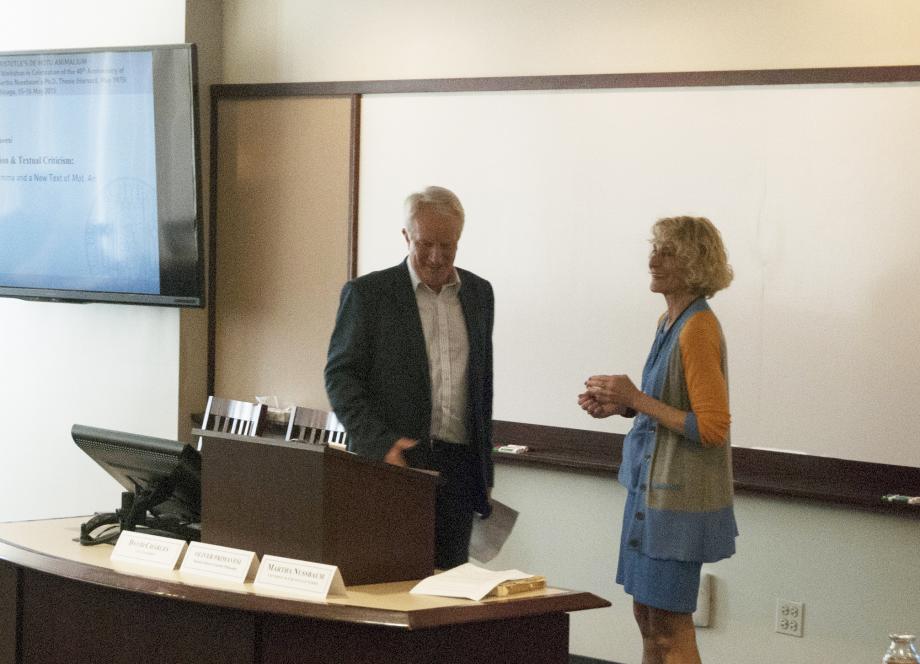Aristotle’s De Motu Animalium: Workshop Celebrates of the 40th Anniversary of Martha Nussbaum’s PhD Thesis

Dhananjay Jagannathan has studied ancient Greek and Roman philosophy at the Universities of Texas, Oxford, and Cambridge. He is presently writing a doctoral dissertation on Aristotle's ethics at the University of Chicago under the supervision of Martha Nussbaum and Gabriel Lear.
Forty years ago, Martha Nussbaum, the Ernst Freund Distinguished Service Professor of Law and Ethics, submitted her Harvard doctoral dissertation on Aristotle’s little-known treatise On the motion of animals. For centuries the treatise, typically known by its Latin title De Motu Animalium, had languished in a backwater of the Aristotelian corpus, neglected by classicists, historians of science, and philosophers, in part due to ill-founded doubts about its authenticity.
As leading scholars of Aristotle gathered on May 15 and 16 at the Law School to mark the anniversary of the dissertation, discussion ranged over the transmission of the texts of Aristotle from antiquity, Aristotle’s enormously influential but widely misunderstood teleological natural philosophy, and the ethical significance of the complexities of animal life. The dissertation broke new ground in each of these areas, and was published in revised form three years later as Aristotle’s De Motu Animalium (Princeton University Press, 1978), with text, translation, commentary, and interpretive essays on major philosophical themes. The conference, therefore, was an opportunity for new and longtime readers of Aristotle to return to this work with an eye to the conversations sparked by its publication in the decades since.
Perhaps most remarkable is the confirmation in recent work by Oliver Primavesi of the Munich School of Ancient Philosophy, who co-organized the conference with Yale University’s David Charles, of Nussbaum’s bold hypothesis that the manuscripts of De Motu Animalium betray traces of influence from a lost edition of the text. Since scholars must compare the surviving versions and weigh alternate readings in order to establish what the text of Aristotle looked like in antiquity, finding even a trace of an independent textual tradition could lead to significant changes. As it happens, two manuscripts analyzed by Primavesi, which had previously been misidentified and so ignored, are perfect examples of this independent tradition. The result is some 86 alternate readings in a text of fewer than 10 pages in the standard edition.
Nussbaum’s edition of the text was the product not only of a careful re-inspection of known manuscripts but also of a fresh investigation of sources such as the thirteenth century Latin translation of William of Moerbeke, who had access to now-lost Greek manuscripts, as well as of philosophical insight into what Aristotle could and could not have been saying. While the discussion of Primavesi’s work largely focused on how this or that difficult passage in the text of the De Motu should be read, the participants concluded by exhorting the next generation of scholars of ancient philosophy to undertake such philosophically informed textual criticism.
The three other speakers revisited the contributions Nussbaum made in her work on the De Motu to the interpretation of Aristotle’s systematic thought and to contemporary philosophy, each indicating substantial sympathy to the goals of her work while also raising points of resistance to her arguments.
Christof Rapp began by taking up the nature and purpose of the De Motu, which fearlessly interweaves an account of the psychological and biological underpinnings of animal movement with cosmological reflections. Nussbaum claimed in her 1978 book that the De Motu showed that Aristotle eventually came to adopt a flexible approach to the interrelation of the sciences, as he considered whether the special case of animal motion provided confirmation for or posed a challenge to his natural philosophy. Rapp argued that the treatise’s overarching goal is to identify how the soul moves the body, which leaves the discussion of cosmology as either a source of insight into general principles of motion or a deviation from the argument that neither violates Aristotle’s separation of the sciences nor supports Nussbaum’s integrative view.
In his talk, David Charles defended Nussbaum’s view that when Aristotle analyzed animal self-movement using concepts from his theory of logical inference, he was trying to schematize goal-directed behavior not characterize practical reasoning. That is why the De Motu engages in the project of explaining animal and human action at the same time, since practical thinking plays the role for us that desire plays for other animals. Charles then proposed an amendment to this view, claiming that Aristotle takes the conclusions drawn in practical thought to be causally responsible for bringing about actions and not constitutive of the actions themselves.
Finally, Klaus Corcilius spoke on one of the most philosophically exciting aspects of Nussbaum’s interpretation of Aristotle, the idea that imagination (phantasia) plays a central role in the life of animals. Corcilius claimed that few critics of Nussbaum’s interpretation have realized its philosophical significance as an account of animal agency, that is, as making sense of how animals are not automata but respond intelligently to their environments. He nevertheless argued that we need not accept Nussbaum’s thesis that imagination is essentially interpretive, since perception and desire can do most of the work for non-rational animals.
The conference concluded with Nussbaum’s reflections on how her early work on Aristotle has continued to inform her more recent work in moral and political philosophy, such as her 2004 book Hiding from Humanity: Disgust, Shame, and the Law (Princeton) and her 2006 Frontiers of Justice: Disability, Nationality, Species Membership (Harvard). Nussbaum noted that Aristotle himself does not draw out conclusions for ethics in the De Motu, but that its central idea of giving a common account of human and animal movement suggests that we must both explore our animal nature, which many traditions of philosophical and religious thought have tended to deny or obscure, and take up the difficult moral questions involved in treating other animals properly.